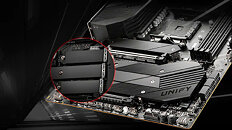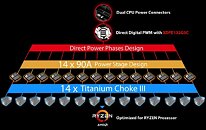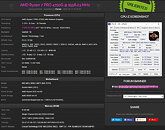Tuesday, October 27th 2020

MSI Announces MEG B550 Unify series
MSI, a world-leading gaming motherboard manufacturer, proudly announces the new flagship AMD B550 motherboards - MEG B550 UNIFY and MEG B550 UNIFY-X. The spirit of the UNIFY series consists of modest and pure black design, emphasizing the real value of the motherboard that can be brought to the demanding gamers and power users instead of fancy LED decorations. By eliminating all the redundant RGB LEDs and adopting the UV black printing, the heatsink shows the gleam and the shining reflection of the dragon that symbolizes a mysterious and high-quality image. For the UNIFY series motherboard, MSI put great efforts into those essential parts concerned by those enthusiast gamers, enhancing not only the thermal but also power solution to run with the AMD Ryzen processors.
Emphasizing the ultimate performance, MEG B550 UNIFY brings astonishing overclocking records to enthusiast gamers. With AMD Ryzen 5 3600XT processor, it is an incredible result to push CPU frequency to 6155.35 MHz, becoming the world's record breaker once again.QUADRUPLE M.2 CONNECTORS WITH DOUBLE SIDE SHIELD FROZR
MEG B550 UNIFY series motherboard features exclusive onboard quadruple M.2 connectors for the maximum storage performance. Three of them support Lightning Gen 4 solution which is the fastest onboard storage on the market with up to 64 Gb/s transfer speed.To sustain the higher performance of ultra-fast storage devices, the MEG B550 UNIFY series motherboard features exclusive double-sided M.2 Shield Frozr. This next-generation M.2 thermal solution prevents throttling by offering the best thermal protection to make sure that SSD maintains maximum performance.
DIRECT 14+2 PHASES WITH 90 A POWER STAGE
To handle the high-performance CPU, the MEG B550 UNIFY series motherboard features extreme power designs including a total of direct 14+2 digital power phases, 90 Amp power stage and Titanium choke III. Combining dual power connectors and exclusive Core Boost technology, the MEG B550 UNIFY series motherboard is ready to break the world record.PREMIUM THERMAL SOLUTION
Cooling is what an enthusiast gamer would care about and the MEG B550 UNIFY series motherboard adopts a premium thermal solution to cool down your system. An aluminium cover with an extended heatsink on top of the power delivery circuits can effectively help dissipate excessive heat. Other than that, a heat-pipe connected from this larger heatsink to another MOS heatsink and an improved thermal pad means better heat conduction.
2.5G LAN WITH WI-FI 6 AX
MEG B550 UNIFY series motherboard features onboard 2.5G LAN plus the latest Wi-Fi 6 AX solution. 2.5G LAN provides incredible data transfer speed faster than ever before. The Wi-Fi 6 AX solution is a revolutionary network with up to 4x network capacity and efficiency in high signal density environments.
DEDICATED FOR EXTREME OVERCLOCKING
The MEG B550 UNIFY offers 4 DIMM slots, but there is a special edition for extreme overclockers - MEG B550 UNIFY-X. This model comes with only 2 DIMM slots for an even clearer memory signal to explore the boundaries of memory overclocking and is ready to surpass all limits!MSI's in-house overclocker, Kovan Yang pushing the DDR4 speeds to an incredible 6536 MHz, show the strength on memory overclocking performance for MEG B550 UNIFY-X.
Emphasizing the ultimate performance, MEG B550 UNIFY brings astonishing overclocking records to enthusiast gamers. With AMD Ryzen 5 3600XT processor, it is an incredible result to push CPU frequency to 6155.35 MHz, becoming the world's record breaker once again.QUADRUPLE M.2 CONNECTORS WITH DOUBLE SIDE SHIELD FROZR
MEG B550 UNIFY series motherboard features exclusive onboard quadruple M.2 connectors for the maximum storage performance. Three of them support Lightning Gen 4 solution which is the fastest onboard storage on the market with up to 64 Gb/s transfer speed.To sustain the higher performance of ultra-fast storage devices, the MEG B550 UNIFY series motherboard features exclusive double-sided M.2 Shield Frozr. This next-generation M.2 thermal solution prevents throttling by offering the best thermal protection to make sure that SSD maintains maximum performance.
DIRECT 14+2 PHASES WITH 90 A POWER STAGE
To handle the high-performance CPU, the MEG B550 UNIFY series motherboard features extreme power designs including a total of direct 14+2 digital power phases, 90 Amp power stage and Titanium choke III. Combining dual power connectors and exclusive Core Boost technology, the MEG B550 UNIFY series motherboard is ready to break the world record.PREMIUM THERMAL SOLUTION
Cooling is what an enthusiast gamer would care about and the MEG B550 UNIFY series motherboard adopts a premium thermal solution to cool down your system. An aluminium cover with an extended heatsink on top of the power delivery circuits can effectively help dissipate excessive heat. Other than that, a heat-pipe connected from this larger heatsink to another MOS heatsink and an improved thermal pad means better heat conduction.
2.5G LAN WITH WI-FI 6 AX
MEG B550 UNIFY series motherboard features onboard 2.5G LAN plus the latest Wi-Fi 6 AX solution. 2.5G LAN provides incredible data transfer speed faster than ever before. The Wi-Fi 6 AX solution is a revolutionary network with up to 4x network capacity and efficiency in high signal density environments.
DEDICATED FOR EXTREME OVERCLOCKING
The MEG B550 UNIFY offers 4 DIMM slots, but there is a special edition for extreme overclockers - MEG B550 UNIFY-X. This model comes with only 2 DIMM slots for an even clearer memory signal to explore the boundaries of memory overclocking and is ready to surpass all limits!MSI's in-house overclocker, Kovan Yang pushing the DDR4 speeds to an incredible 6536 MHz, show the strength on memory overclocking performance for MEG B550 UNIFY-X.







12 Comments on MSI Announces MEG B550 Unify series
I approve of this. SATA drives are losing popularity and being relegated to NAS boxes or USB enclosures for a lot of people now. We're already up to 7GB/s for PCIe storage and the 550MB/s of SATA looks decidely pointless, almost as pointless as a 2nd and 3rd double-wide PCIe slot for gaming GPUs.... :D
If only it used Intel I225-V instead of that Realtek controller.I think this is missed by most PC users.
It doesn't really matter if the built-in sound chip is excellent on paper, the problem is EMI. Having a separate PCIe sound card may only help a tiny bit if anything at all, and probably only if it has separate power filtering. The underlying problem is the sensitive signal coming out of the DAC, and is easily solved by using an external DAC as you are saying. These days there are plenty of solid DAC options, there is no need to spend a lot of money on it. There is also the added benefit of having the volume adjustment after the DAC instead of having it in the OS, which results in a physical button on your desk and smooth volume adjustment.
The only feature I would use of onboard audio would be the TosLink passthrough, but only since one of my DACs is a multi-input DAC.
I also think all this "EMI shielding" talk is a bit overblown - even when using analog outputs never have I heard any noise/distortion etc... And my case (old, modified CM Stacker 810) is pretty bad in terms of shielding...
As for hearing any noise, I've certainly heard it on a lot of computers, probably nearly all the ones I've tried. The symptom is a higher noise floor, and sometimes hiss, pops, jitter, etc. It will certainly depend on the power draw of other components, like GPUs. For many computers I've found it very annoying when using proper studio earphones and listening at fairly low volumes. I've not been able to hear any difference between expensive and cheaper external DACs, but certainly between any external DACs and an integrated sound card.